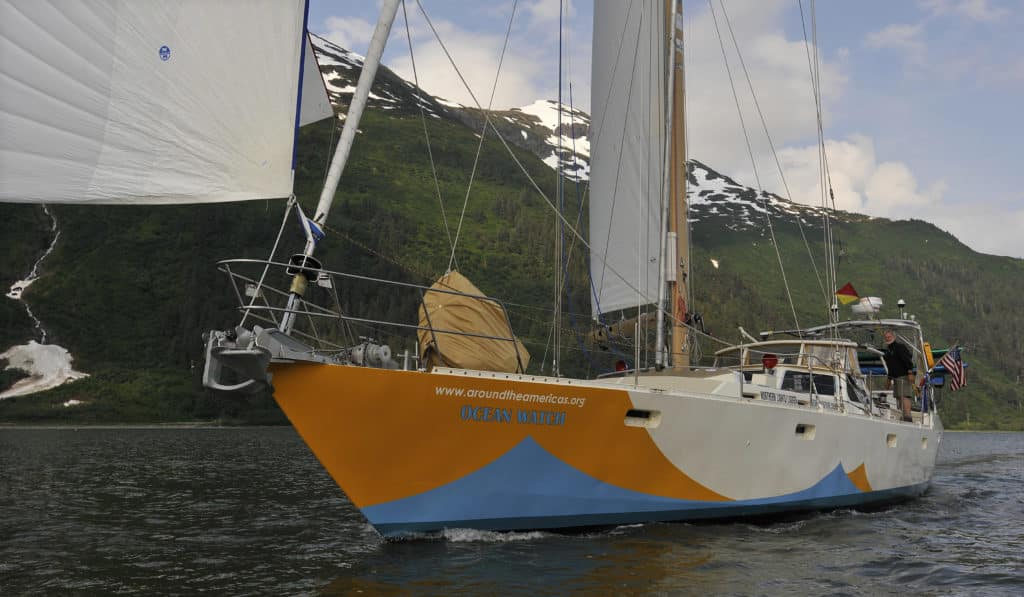
My first night offshore on the yacht that would become Ocean Watch was a certified shocker. The previous evening, I’d flown into Cabo San Lucas, Mexico, straight from the 2008 running of Antigua Sailing Week to begin the delivery north to Seattle, Washington — a destination that proved too far on this particular trip (ultimately, we would make it to San Francisco on this leg and return for the final push to the Pacific Northwest at a later date).
Just hours into the voyage, slamming upwind into a staunch northerly and hellish accompanying seaway — making 3.5 knots over the ground — I was wishing I was back in the Caribbean or, for that matter, anywhere else on the planet. What was worse was the knowledge that, aboard this very vessel, I’d signed on for a 28,000-nautical-mile voyage around the Americas via the Northwest Passage and Cape Horn. We’d budgeted about 13 months for the expedition, which at that moment seemed laughable. The way we were going, it appeared it would take that long to reach San Diego.
Danzante III, as she was then called, had been in service for the previous decade as a research vessel for a married pair of marine biologists, who lived aboard full time while studying Humboldt squid in the Sea of Cortez. The 64-foot Bruce Roberts-designed pilothouse cutter had been constructed of steel by a skilled welder on the Maryland shore of Chesapeake Bay, and she had, as they say, good bones. But her extremely tired in-mast furling mainsail was shapeless and sad, and her listless Westerbeke diesel was on its last stumbling legs. Even motorsailing to weather was a bad joke.
And that’s not even half of it. Almost all the systems, including the generator, wiring, plumbing and electronics, were in need of either a serious upgrade or outright replacement. Before circumnavigating North and South America, she needed a total refit.
Eventually, through almost sheer stubbornness, the boat made it to Seattle and was hauled out at the Seaview East Boatyard in Ballard, a neighborhood in the northwest part of the city. With skipper Mark Schrader, project manager Dave Logan, foreman Paul LaRussa and boat captain Andy Gregory all leading a team that would ultimately engage a large posse of Ballard tradesmen and craftsmen, the all-encompassing project commenced.
As our journey, sponsored in large part by the nonprofit group Sailors for the Sea, was meant to raise awareness of ocean-conservation issues, we would also be bringing aboard scientists and oceanographers for different stretches of the adventure. And they, of course, would be bringing instrumentation and computers to add to the already-significant number of laptops the crew would employ. Plus, we had strict deadlines to meet, which meant that we needed a reliable diesel engine. So the single biggest job was replacing the old auxiliary. A Lugger Marine 135-horsepower diesel took the place of the gasping Westerbeke, and to power all the instruments and computers, a new 12.5-kilowatt Northern Lights generator was also installed.
Once the Lugger was in, everything else could start coming out: much of the interior furniture, roughly 300 pounds of wire, and what seemed like miles of hose, all to be replaced with fresh components and new berths to accommodate an expedition-style crew. Three banks of absorbent glass mat batteries were also added, along with a Village Marine reverse-osmosis watermaker, an 80,000 Btu Webasto central-heating system to keep things toasty in the high latitudes, a state-of-the-art integrated electronics package from Raymarine, and much, much more.
Because the cost of an entirely new mast and rigging was prohibitively expensive, the plan was to change the existing rig from one with a furling main to one with a conventional mainsail that had its own dedicated track. A new extrusion, along with the hardware and fittings for a traditional main, and including full-batten cars and a fresh track, was fitted and bolted onto the original spar, with a few reinforcing tabs strategically placed in the mast.
For sails, we commissioned old friend Carol Hasse at nearby Port Townsend Sails to build a new inventory that included a mainsail with three deep reefs (negating the need for a storm trysail), a 115 percent roller/furling jib, a working staysail and a storm staysail. A nifty cruising gennaker from North Sails, emblazoned with a giant map of the Americas, rounded out the package.
When we departed Seattle in the late spring of 2009, we were sailing the rechristened Ocean Watch: With countless other improvements too lengthy to address here, she was a new boat and deserved a new handle. Several weeks later, bashing across the stormy Gulf of Alaska quickly and purposefully, the awful first night off Cabo truly seemed like a nightmare from another life. And that was a very good thing indeed.
Herb McCormick is CW’s executive editor.








